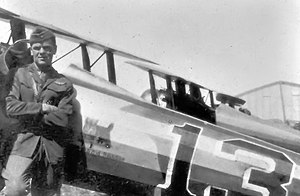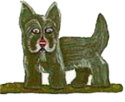147th Aero Squadron
| 147th Aero Squadron | |
|---|---|

Lt. Wilbert Wallace White, 147th Aero Squadron. He was a Flight Commander for the Squadron and gained 8 victories during his service.
|
|
| Active | 11 November 1917-Present |
| Country |
|
| Branch |
|
| Type | Squadron |
| Role | Pursuit |
| Part of | American Expeditionary Forces (AEF) |
| Engagements |
World War I |
| Commanders | |
| Notable commanders |
Maj. Geoffrey H. Connell Lt. John A. Hambleton Capt. James A. Meissner |
| Insignia | |
| 147th Aero Squadron Emblem |  |
| Aircraft flown | |
| Fighter |
Nieuport 28 Royal Aircraft Factory S.E.5 Airco DH.4 Spad XIII |
| Trainer | Curtiss JN-4, 1917 |
| Service record | |
|---|---|
| Operations |
1st Pursuit Group Western Front, France: 29 May-11 November 1918 |
| Victories |
Air Aces: 6
|
Air Aces: 6
The 147th Aero Squadron was a Air Service, United States Army unit that fought on the Western Front during World War I.
The squadron was assigned as a Day Pursuit (Fighter) Squadron as part of the 1st Pursuit Group, First United States Army. Its mission was to engage and clear enemy aircraft from the skies and provide escort to reconnaissance and bombardment squadrons over enemy territory. It also attacked enemy observation balloons, and perform close air support and tactical bombing attacks of enemy forces along the front lines.
After the 1918 Armistice with Germany, the squadron returned to the United States in March 1919 and became part of the permanent United States Army Air Service in 1921, being re-designated as the 17th Squadron (Pursuit).
The current United States Air Force unit which holds its lineage and history is the 17th Weapons Squadron, assigned to the USAF Weapons School, Nellis Air Force Base, Nevada.
The 147th Aero Squadron began as a widely scattered group of men, mostly in Texas who arrived at Kelly Field during the summer of 1917 where they spent time on learning the rudiments of soldiering. On 10 November 1917, the unit was organized and given a designation. Once formed, they were ordered to proceed to Everman Field (#2), Camp Taliaferro, Texas, near Fort Worth. At Everman Field, the men received a most practical and excellent training in the hands of the Canadian Royal Flying Corps. The course training for mechanics being completed, the squadron was then transferred to Hicks Field (#1) at Camp Taliaferro, where primary flight training was conducted for the flight cadets.
When formed, the squadron consisted of some 300 men, all of which were candidates for flying training. The rapid and thorough training given by the RCFC resulted in numerous accidents. Training consisted of bombing, photography, contact patrol, artillery observation, and scout combats and patrols. Upon completion of the training, the 147th Aero Squadron consisted of 30 flying officers and 193 men, with five more pilots to follow. On 14 February 1918, the squadron entrained at Hicks Field, and was bound for Garden City, New York for overseas travel. The squadron arrived on the 19th and was quarantined, as the camp was in an ill condition. The officers were kept clear of the quarantine and spent their time in New York City or at home if possible. On 5 March the 147th was ordered to board the RMS Cedric bound for Liverpool, England. A stop was made at Halifax, Nova Scotia on 8 March, and the trans-Atlantic trip was uneventful. Landing was made at Liverpool on 14 March. After disembarking, the squadron was marched from the docks to the Liverpool railway station where it boarded a London and North Western Railway train which took them to Winchester, Hampshire, near the south coast of England. Arriving in the late afternoon the squadron was moved to the Romsey Rest Camp. Everyone was held in camp until 21 March, when the squadron traveled by train to Southampton in the morning. That afternoon, the men boarded the "Northwestern Miller", which left the harbor in a thick fog, also carrying horses and cattle.
...
Wikipedia
